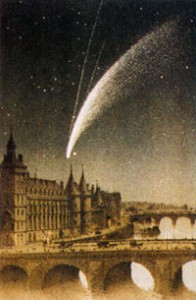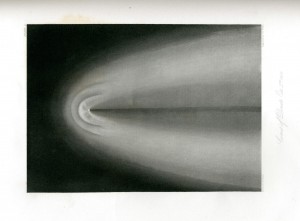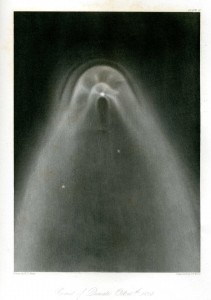No. 7 in our weekly comet profile is Donati’s Comet. After the Great Comet of 1811, Donati’s is known as the most brilliant comet of the 19th century. I posted one image of Donati’s Comet already, on May 1, but here she is again, seen above Paris in October 1858:
Donati’s Comet was famous for its shroud-like coma. For one stretch of three weeks, the comet expelled a new coma every 4 1/2 hours, like a woman casting off a series of veils.
Here are some more images, from “An Account of Donati’s Comet of 1858” (Cambridge, 1858), by George Bond, who also made the sketches:
Edwin Emerson’s “Comet Lore” (New York, 1910) has this to say about Donati’s Comet:
“This Comet, which appeared to be charging straight down from the zenith, and had a curved tail, was observed from June 1858 to April 1859. It was seen at its brightest in the South, in Italy, Mexico and in the Far East. While it shone over the Far East there were bloody wars between the British and the risen people of India; between the British and the Chinese, who objected to having opium thrust upon them; while Japan was in the throes of revolution and civil war. In Mexico the standard of revolt against the clericals was raised by Juarez, thus plunging Mexico into civil war and war with France. Immediately after the disappearance of the Comet war broke out in Italy between the French and Italians on one side and
the Austrians on the other, ending in the bloody Battle of Solferino.”
A lot to lay on a comet.
Closer to home, Senator Abraham Lincoln observed the comet from the porch of his hotel in Jonesboro, Illinois, as he prepared for a debate against Stephen Douglas–one of the historic Lincoln-Douglas debates over the future of slavery in America, in which Lincoln famously declared “A house divided against itself cannot stand.”
A person of a novelistic bent might imagine that Donati’s Comet helped inspire these words from Lincoln, and thus, in a roundabout way, a comet helped to bring about the end of slavery in the United States.


